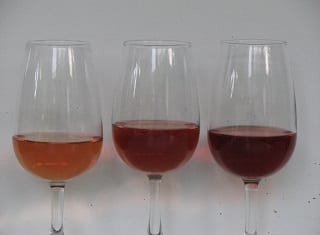
Different rosé colour nuances.
The international consumption of rosé wines has increased by 8% over the past 10 years. France is presently producing almost a third of it. The Provence province in south-east France produces 42% of it. Producers have also learned that consumers require more vegan or vegetarian-friendly wines. Provence producers have also had to adjust to comply with this.
The first question is whether a premium quality rosé wine, which is vegan or vegetarian friendly, can be made. It can be done by replacing the previous use of casein and PVPP to limit the uptake of phenols with potato protein (patatin) or pea protein in combination with PVPP.
It is important to apply all the winemaking processes from the harvest of the grapes correctly to make a premium rosé. It includes especially the correct management to limit the oxidation of phenols. If the phenols are not removed, browning of the wine can occur, important volatile aromas can be oxidised and antioxidants, which have to prevent oxidation can be scavenged. It is ideal to hand pick grapes during the night, which will limit the grape damage and consequently limit enzymatic oxidation. It is however not always practical, which makes it important to manage the different juice fractions correctly. Hand picking can still be used and the grapes must preferably be cooled to limit enzymatic oxidation. If mechanical harvesting is however used, the juice fractions of the undamaged berries in the hopper can be separated from the other juice fractions. If a juice fraction is heavily oxidised, a spectrum of fining agents at a high dosage will be required if animal-based fining agents like casein and gelatine cannot be used. Increased handling and pressing of the skins will liberate more phenolic compounds into the juice. In Provence a press, which together with enzyme additions promote the juice yield and the liberation of aroma precursors from the skins without mechanical action, is preferred. The ideal is to gain as much as possible of the precursors as quickly as possible to limit potential oxygen uptake and the extraction of phenolic compounds. If this is not done, strawberry and raspberry fruit flavours can be obtained, but delicate flavours like flowers, white peach, grapefruit and passion fruit will not be obtained. The press cycle of the skins is also important. The application of sparkling wine press cycles minimises the press rotation and increases the pressure gradually, without decreasing the pressure between press fractions. This limits oxidation during pressing. The use of dry ice in the grapes ensures that an inert atmosphere is created.
The removal of phenolic acids will prevent a change in colour and the oxidation of the thiol flavours. Comprehension must also exist for the difference between chemical and enzymatic oxidation. Sulphur dioxide and ascorbic acid can control enzymatic oxidation to a certain extent, but chemical oxidation can still occur over time. It is consequently essential to remove phenolic acids, which can otherwise be oxidised at a later stage.
The effective fining of juice usually requires dosing with a venturi, when the juice is still cold. The uptake of oxygen during this process is limited by the low temperature. Flotation can be a handy process to add the fining agents, without unnecessary oxygen uptake. Many Provence winemakers add the fining agents during the first third of alcoholic fermentation. Each fining agent has specific characteristics regarding size and results. Some can react with the polyphenols in the juice, while other will react with polymerised tannins. Combinations with PVPP can be used to remove the full spectrum of phenols, which can oxidise colour and flavours. Casein and PVPP combinations are critical when the juice is already oxidised and has an orange colour.
Rosé wine is associated with fruitiness. The use of sound good quality is a basic requirement for this attribute. Red grapes can contain the same concentration of thiol precursors as Sauvignon blanc, but phenols in the juice can bind it and make it non-volatile. It is consequently important to remove such phenols and use yeast strains, which can convert the precursors into thiols to produce fruity rosé wines.
The mouthfeel of rosé wines can be improved by keeping the juice at 0°C for 7 to 14 days and circulating the lees twice daily with dry ice or nitrogen. It can increase the polysaccharide concentration in the juice, which will have an impact on the mouthfeel.
An acceptable colour is a basic requirement for rosé wines. The colour is influenced by the cultivar, fining agents, sulphur dioxide concentrations, harvesting methods, enzyme additions, destemming and crushing. If all the phenolic compounds, that are responsible for oxidation are removed, the colour should not change, but if it is not the case the colour will gradually change to brown or orange. In Provence cellars usually have rosé wines with different colours and intensity, which can be blended to ensure an acceptable colour in the wine.
Stabilisation of Provence rosé wines are done in standard ways. Sodium bentonite is used during fermentation and after final blending for protein stabilisation. Carboxymethylcellulose (CMC) is used for tartrate stabilisation (Rossi et al., 2019).

Provence map.
Reference
Rossi, C., Seabrook, A. & Mariani, A., 2019. Vegan rosé – lessons from Provence. Australian and New Zealand Grapegrower and Winemaker, February 2019: 54 – 57.













